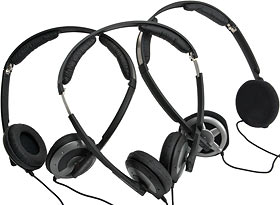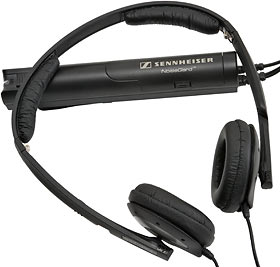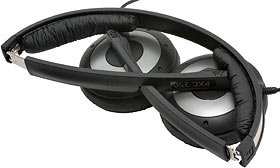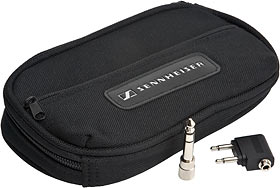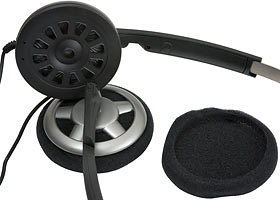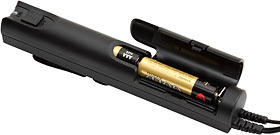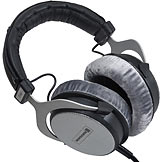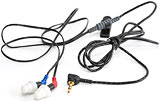
Sennheiser PX 100, PX 200 and PXC 250 portable headphones
Review date: 30 June 2004.Last modified 03-Dec-2011.
Ever since Sony introduced their first Populace-Pacification Device (page 130), personal stereo users have been trying to find a decent pair of headphones.
The average quality of bundled headphones today is better than it used to be, but when you buy a cheap portable player of some kind - and this definitely includes a lot of MP3 players - you're probably still going to get a truly ghastly set of headphones with it. Probably not the classic springy-headband orange-foam-cushioned classics from the '80s, but the little earbuds that come with a lot of players today have depressingly similar telephone-like frequency response.
A lot of portable listening aficionados today are in love with "canalphones", the earplug-like headphones that give high isolation (blocking of outside noise) and, generally, exceedingly good sound reproduction as well. But high isolation's dangerous in many mobile listening situations, and not everybody likes earplugs, and even people who don't particularly mind having something stuck in their ear still probably don't want the things there for hours on end, if there's an alternative.
Plus, they're kind of icky. Conventional headphones may get a bit greasy, but canalphones take it to a whole new level, unless you dice with deafness daily.
There's no law against wearing full-sized headphones out in public (probably not even in Singapore), so if you feel you can pull off such a daring fashion statement, go ahead. There are many full-sized headphones with low enough impedance and high enough efficiency that portable players can drive them perfectly well.
If you'd rather not look like Audiophilicus Preposterii in public, though, and don't want your ears invaded either, you need some lightweight quality headphones.
Tah-daaah.
You're looking at three closely related Sennheiser products, meant for use on the move by people who care about sound.
In increasing order of price, they are:
The PX 100. Open-backed headphones (so they let outside noise in, and inside noise out) that sell, here in Australia, for about a hundred bucks delivered. Aus PC Market has them for $AU99, including delivery anywhere in the country. The US list price is $US49.99, but you can find them for about ten bucks less, ex delivery.
(I am, by the way, going to try an experiment in this review: I will attempt to refer to these things in the singular, as "the PX 100" and so on, not "the PX 100s". This may lead me to referring to legwear as "a pant", but hey, that could end up being a career in itself.)
The PX 200. Similar to the PX 100, but with a sealed back and, thus, little teeny ring-cushion earpads instead of the flat foam-cushion ones on the PX 100. $AU132 delivered from Aus PC Market; about $US50 street price in the States.
The PXC 250. The headphone part's almost the same as the PX 200, but it's got active "Noisegard" noise cancelling, thanks to an external electronics module that pushes the Australian delivery-included price up to $AU286. US street price around $US130.
At a glance, you'd assume that with headphones this similar, there wouldn't be any surprises in store. Cheap ones OK, middle ones nicer, expensive ones best. Right?
Wrong.
Bits and pieces
All three headphones have this little party trick. This is the PXC 250, but the others work the same way. The earpads are on a ball joint arrangement that lets them swing 90 degrees away from their operating position, and after you've done that, you swing the hinged arms inwards, and clip a couple of matching notches together to lock the headphones in the closed position. One of the extensible arms needs to be extended a bit for the notches to line up, but it's really not a difficult trick; the biggest problem is making sure you don't tangle one of the wires through the folded arms.
(You can, by the way, even download folding instructions from the Sennheiser site.)
The arm extension has a simple ratchet-click action, and the hinge seems pretty sturdy.
The headphones also have headband cushions - two little curved fake leather arrangements, one on each side. They provide an excellent compromise between slimness and comfort.
The PX 100 and PX 200 come in these nifty hinging plastic cases, which include a cord-winder for the 1.4 metre (4.6 foot) cable. Rather disturbingly, the cord-winder actually pretty much works; you need take only a little care to make sure the cable doesn't get pinched in the case when you close it. There's a push-to-open clicky latch that should stop the case opening when you don't want it to, and the headphones fit in it snugly enough that they shouldn't fall out even if it does. Some of the wound-up cable's exposed when the case is closed, but it shouldn't be particularly snaggable unless you've wound it loosely. You should be able to put these cases anywhere you'd put a hard glasses case; they're about the same size.
The PXC 250's extra electronics module means it won't fit in one of the plastic cases, so you get this little padded zip-up pouch instead, with a belt loop on the back and a sub-pocket on the front. The pocket contains, as standard, a 1/8th to 1/4 inch plug adapter, and a dual-mono adapter for using the PXC 250 with standard airline headphone sockets.
The PX 100 and 200 don't come with any adapters; if you want even a 1/4 inch converter, you'll have to supply it yourself.
The PX 100 and 200 also, by the way, each have a modest 32 ohm input impedance, which is pretty normal for small headphones. This means practically any portable player should be able to drive them to decent volume; their efficiency is OK, so you don't need a lot of input volts to get decent output noise.
The PX 250 has an unusually high 300 ohm nominal impedance (I measured it at 230 ohms), so it plays rather quieter at a given volume control setting. The electronics module provides its own amplification, though, so you ought to be able to get decent loudness out of the PX 250 in pretty much all situations too, as long as there's some life in the batteries.
The PX 100 earpads are the ordinary, easily removed thin foam type. I took this photo not long after taking the PX 100 out of its case for the first time, so the earpads still had flat spots on their edges; they rounded out over a few hours.
The PX 200 and PXC 250 have practically identical earpieces; this is the 250, but the 200's only cosmetic difference is that it has silvery plastic on the earpieces where the 250 has black, and vice versa.
At a glance, these look like regular "circumaural" round-the-ear headphones, but the pads, like those of the PX 100, are less than five centimetres (two inches) in diameter. They sit on your ears, not around them, so they're "supra-aural".
The PXC 250 electronics module runs from two AAA batteries. There's about a metre (3.3 feet) of cable between the headphones and the module, and about another 80cm (2.6 feet) of cable between the module and the input plug.
The PXC 250 noise cancellation hardware operates in much the same way as every other noise-cancelling headphone. Little microphones in the headset detect ambient noise, and the hardware generates a reversed-waveform version of the noise that's overlaid on top of the input signal, to cancel it out.
Also as usual for noise-cancelling 'phones, you can turn on the PXC 250 module and enjoy the noise reduction, or you can leave it off and just use the headphones as regular passive units. So you won't be stuck if your batteries go flat.
That shouldn't happen too often, anyway. Through my multimeter, the PXC 250's power draw sat on about 13mA when the electronics module was on but not getting a signal. Playing loud, it spiked as high as 20mA, but averaged maybe 16mA. The current was reduced a bit by the resistance of the meter, but you still ought to be able to count on at least 30 hours of continuous play time from a pair of cheap off-brand alkalines, and possibly quite a lot more.
There's a single red LED on the end of the electronics module to tell you when it's on; it flashes when the AAAs are low.
There's a rotating clip on the back of the module, which should make it easy to hook the thing onto the belt, pocket, backpack strap or what-have-you of your choice.
As you'd expect, none of these things are very heavy. Around 60 grams (2.1 ounces) for the PX 200 or PXC 250 headsets, sans cable; around 135 grams (4.8 ounces) for the PXC 250 headset and electronics module (with batteries and cables); about 55 grams (oh, work it out for yourself) for the PX 100, and a whopping extra 70 grams or so for the PX 100 and 200 plastic cases.
Here, for the curious, is the component side of the PXC 250 circuit board.
Listening
I was the kind of kid - actually, I'm also the kind of adult - who always ate the best lollies first, so I auditioned the PXC 250 before the other two headphones.
Unlike proper circumaural sealed headphones, the PXC 250 earpads didn't come anywhere near sealing off my ears from the outside world. They're too small to surround the ears, and they can't conform well enough to the folds of the ears to get a decent seal (nothing this size could, unless it was made out of Silly Putty or something), so they let plenty of outside noise in. There's some attenuation of treble noise, but Sennheiser's claim that the "soft ring ear pads with improved fit and closed ear cups ensure excellent passive attenuation of ambient noise (–15 to –25 dB for frequencies above 1,200 Hz)" is a severe overstatement, if you ask me.
This is a problem, because the PXC 250 noise cancellation hardware, like every active noise reduction headphone system I know of, isn't a wide-band solution. It attenuates bass-to-midrange noise, not treble. The PXC 250 noise reduction only works below 1000Hz (about two octaves about middle C).
The reasoning behind this for larger and/or better sealed headphones than the 250s is simple enough. Treble attenuation is actually pretty easy to do with passive sound-blocking materials, but the more energetic and penetrative bass sound waves are much harder to stop. Everyone who's heard a nearby party's soundtrack reduced to nothing but WHUD-WHUD-WHUD will know about this; floors and walls can stop higher frequencies pretty well, but bass shakes everything.
Also, treble is more directional and has shorter wavelengths. The shorter the wavelength, the more difference there'll be between the part of the wave one ear hears and the part the other one does, and the more important small errors in the cancellation waveform become.
The speed of sound is about 340 metres per second, so a 340Hz low-midrange tone has about a one metre wavelength. The width of a human head matters a bit at that frequency, but the distance between a noise cancelling headset's microphones and drivers fades into insignificance, and a bit of misalignment in the cancellation waveform isn't a big deal either.
A 10kHz treble note, however, has a wavelength of only about 3.4 centimetres - one of your ears is at least a few whole 10kHz wavelengths away from the other, and if the cancellation waveform's only a couple of thousandths of a second out of whack, it'll be as likely to make the noise louder as quieter.
Makers of noise-cancelling headphones sometimes say that they don't try to cancel high frequency noise out of concern for their customers' safety - they don't want to stop you hearing warning buzzers, sirens, and so on. Suuure. They'd do it if they could.
Advanced noise cancelling systems can compensate for the trickiness of high frequencies, and for all sorts of other squirrelly noise features, with a "feed-forward" design that uses one microphone to listen to the ambient noise and another to listen to the mixture of that noise and the cancellation waveform, so the waveform can be adjusted on the fly. Actually, such a design can theoretically work with only monitoring of the output and reference to the input signal, though it's more complex.
It's nontrivial to make headphones that work this way, though; feed-forward systems work better in cars, or air conditioning ducts, or other large objects. So users of noise-cancelling headsets are stuck with the simpler single-mic design, which takes its best guess at what it should do to cancel only the bass and midrange noise, and just hopes that the results will be good.
All this is my way of warning you that I found the PXC 250's noise reduction to be rather underwhelming. It does something, all right; you can try it out by just popping on the headphones when they're not connected to a signal source and clicking the switch on and off. Less noise, more noise. Less noise, more noise.
But not much less noise. Sennheiser claim attenuation of 15dB or more, which is quite a lot. I heard nothing like that.
My first testing environment was a room full of whirring computers, which isn't kind to a low-frequency-only noise reduction scheme, because computer fan noise has a lot of high frequency components.
When I turned on the noise reduction with no signal going to the headphones, the lower frequency noise certainly was reduced somewhat, but rather less than I'd expect from just putting on a cheap pair of sealed headphones. Because the noise reduction didn't touch the treble, it also made the background noise sound as if it'd hopped up an octave.
(Without an input signal, the noise cancellation also created, for me and my laboratory calibrated research-assisting girlfriend, a kind of congested feeling in the head. This is presumably because of phase differences in what our ears were now hearing; when your sinuses are blocked, you hear similar phase oddities.)
More bass-heavy background noise, such as what you get from planes, trains and automobiles, is meant to be a better subject for this kind of noise cancellation. So I tried the PXC 250 out in the car, as well. Again - it did something, but not much, and all of the really low bass noise got through just fine, because the PXC 250 drivers can't reproduce really low bass at all.
Sennheiser shamelessly claim that the PXC 250 headphones have bass response down to 10Hz. I invite them to pull the other one. The frequency response graph has to be at least 20dB down at 10Hz - far below audibility even at maximum volume, if there are any other signal frequencies going to the headphones at all. The real bass limit of these headphones, the -3dB point where honest specifications should draw the line, may be below 30Hz, but it can't be much below 25. If you've got a luxury car then there may be no sub-25Hz noise to speak of in the cabin. I've got a Pulsar, and there is.
Sennheiser have an explanatory page about "Noisegard", which gives you pretty much no idea at all of what the feature actually sounds like. But it does let you listen to some obnoxiously overcompressed Vivaldi.
A reliable source tells me that the PXC 250 worked very well for him on a long jet flight; I didn't have a plane handy to try 'em out on, so I'll take his word for it on that. I can believe that people's mileage may vary. As a general purpose magical Cone Of Silence, though, which is what Sennheiser say this headphone is, I don't think it cuts the mustard.
Fortunately, the PXC 250 electronics module isn't just trying to subtract noise from the incoming signal. It also considerably amplifies the signal. The headphones play a fair bit louder with the power switch on, and it provides a significant bass boost. These headphones can definitely use that boost, too; with the module turned off, their bass response is quite unexciting.
If you push the earpads onto your ears to create a decent seal then bing, there's some nice low bass; I dare say people whose ears happen to have a shape that better suits the earpads than mine do, and who manage to keep the 'phones lined up right as they move, will be happier than I was with the PXC 250. It all seems too much like hard work to me, though. Without a good seal, the PXC 250's bass response is OK, by small headphone standards, as long as its electronics module is turned on, and is quite lousy otherwise. The bass all just leaks out the sides.
Apart from that, the PXC 250 sounds pretty good, at least when the electronics is turned on.
But so do a lot of other small headphones that cost a lot less and don't need batteries. Hmm.
The same, only less so
OK. Enough cruelty to the PXC 250. Time to malign the PX 200.
Since the PX 200 is, basically, the PXC 250 headphone module without any of the active electronics, it's got all the same problems that the PXC 250 has when its power switch is off. Crummy bass, little isolation. Lower impedance, so more noise from a given volume control setting, but that's it for the differences.
If the earpads happen to fit your ears, you might like it. If they don't, then its rather lower price and neat-o plastic case still don't make the PX 200 worth buying.
The good news
And so, on to the PX 100.
Well, I'll be darned.
That's where the bass that the 200 and 250 were meant to have went. Into the cheap model. This thing kicks.
While listening to the PX 100, I was tempted to take the headphones off and check to make sure these were, in fact, little portable 'phones. They sure don't sound like it.
Ample bass - pretty much as good as the 200 and 250 managed when I squished them onto my ears. No horrible resonance issues. Crisp treble with no over-emphasis. OK, the PX 100 is maybe a tad muddy low down, and it's not without a bit of noticeable midrange resonance, but for this money and this size, the PX 100 is great.
And because the PX 100 is an open-back headphone that doesn't need to seal against your ears, it doesn't try. So it clamps your head a bit less than the two more expensive folding 'phones. The difference isn't large; the PX 200 and PXC 250 aren't real skull-squishers. But it's worth noting, if you expect to be wearing these headphones for a while.
The PX 100 isn't, of course, as comfortable as a big squishy set of circumaural headphones for long-term wear, but it's about as good as a lightweight supra-aural set can be expected to be.
After a bit of swapping to verify the relative character of the PX 100 and the other headphones, I retired the two more expensive models to the Close, But No Cigar pile and settled in for some broader testing of the PX 100.
The usual audiophile reference tracks passed by in good order, and were followed this time by interminable drum solos, non-Muppets music with a lot of reverb, seminal electronica, heartwarming folk music, and microphone-shattering vocal work.
I then tested the limits with the kind of music which, I feel, is helpful to portable stereo users seeking a way to cope with the urban jungle.
(For suitably small values of "cope".)
I followed the above with some similarly raucous material.
The PX 100 acquitted itself tidily throughout.
Oh, and if you want noise cancellation, I got your noise cancellation right here. It's called a volume control. Does the job just fine, and has no drawbacks at all!
Overall
So, the verdict:
PX 200: No thanks. Maybe, if they happen to fit your ears well, but you'd want to try 'em out first to be sure of that.
PXC 250: Perhaps. Again, not much good if they don't fit your ears. If they only cost $US50 then they'd be a great option, but they're substantially more expensive than that, and their noise cancelling just doesn't seem to work that well. If you do a lot of flying, the price of the PXC 250 will probably fade into the background of your expense account, so pick up a pair and see what you think; you may be pleasantly surprised. If the ambient noise you have to deal with is more often made by trains, cars and buses, though, I think you'll be disappointed.
I'm unconvinced that any noise cancelling headphones that aren't full-sized circumaural units are likely to be good for much. You'd think that canalphone variants would be OK, but Sony make such a device - the MDR-NC11, and it would appear that the noise cancelling feature is unimpressive.
People speak well of the more expensive Bose version; that's a big old circumaural design.
Hence: The PX 100 is not just the clear winner among these three, but a great product in objective terms too. Quite cheap, good sounding, insensitive to ear shape, and it folds up in the same nifty way as the other two. Without a good earpad-to-ear seal, there's just no comparison between the bass response of the PX 200 and that of the PX 100. And even with a good seal, the PX 200 still isn't better.
The PX 100 gets a Highly Recommended from me.
Buy 'em!
Readers from Australia or New Zealand can purchase all of these headphones from Aus
PC Market.
For the PX 100,
click
here.
For the PX 200,
click here.
For the PXC 250,
click here.
(if you're NOT from Australia or New Zealand, Aus PC
Market won't deliver to you. If you're in the USA, try a price search at
DealTime!)
